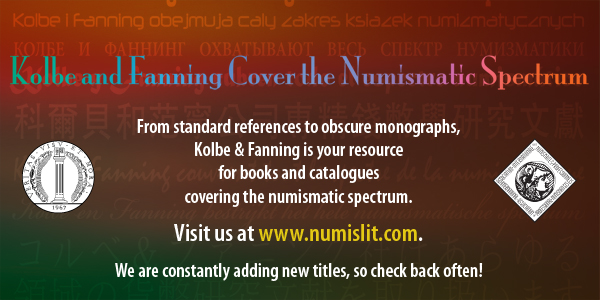
PREV ARTICLE
NEXT ARTICLE
FULL ISSUE
PREV FULL ISSUE
QUERY: HOW DO YOU MAKE AN ELECTROTYPE?
A web site visitor is interested in making electrotypes, and submitted these questions after reading earlier E-Sylum articles.
-Editor
When I was younger I collected ancient Greek and Roman coins. I am getting older now and have to sell them as I don't have any children. I hate to part with them and one day I thought if I could make electrotypes of them I could keep the electrotypes and enjoy them and put the valuable originals in auction. To that end I started trying to figure out how to make them. I have had some success but find there are so many variables to contend with! I read what I could find on line but everything was too general. I read Ken Bressett's article and talked to him when I went down to Colorado Springs but he hasn't tried to make them and so the details are missing. By the way, Ken also collects ancients. I used to work at Carnegie Museum in Pittsburgh in Vertebrate Paleontology so I know how to make molds. I tried wax and sylastic rubber and have had better luck with the rubber molds. I tried using graphite powder (from a lead pencil)--that didn't work, bronze conductive paint (obscured the detail and pulled away from the mold because it is mixed in an acrylic medium) and graphite in a colloidal suspension. The graphite worked the best but the plating isn't perfect. Sometimes there are rough areas (perhaps from a trapped air bubble?). So I am slowly trying to solve this puzzle but there are so many variables. Could your readers be so kind to give me some advice? 1. I like the idea of using a bronze powder for coating the mold. Where can I buy the best quality? 2. Has the monograph on electrotypes mentioned in your article been published? If so, where can I get a copy?
To read earlier E-Sylum articles, see:
ON ELECTROTYPES
(www.coinbooks.org/esylum_v09n43a14.html)
As a Pittsburgh native, I was curious if our reader had contact with the Carnegie Museum coin collection. Here's his story.
-Editor
When I was working at the museum I used to go to the library on Saturdays and just go through the stacks and pull out books that looked interesting. I had collected U.S. coins when I was younger but had lost interest in them. One day I found a book that had photos of ancient coins and they looked interesting to me. I went to Bill Woodside who was the business manager and also ran the coin room. I asked him how do I learn about ancients and he told me to come in Saturday. He had me sit down at a table and he pulled out quite a few late Roman bronzes and a large pile of books. He said "identify them". I told him I didn't read Latin and he said "you'll learn" and walked out of the room. I started going in every Saturday and that is how I met Glenn Mooney. One day Glenn came in with some ancient coins that he had bought in Wilkinsburg. I asked him if there were any more and he said no. I thought I had better check it out. I went to the store and bought a lovely Greek bronze from Syracuse for $3.00. While looking at one of the trays I noticed a lump in one corner and so picked up the felt and there was a Greek silver coin from the Thessalian Confederacy. I was excited and bought it for $10.00. I still have both coins.
What a great story,
I never met Bill Woodside – he died about the time I met Glenn. It was 1978 and I was a student at the University of Pittsburgh. I read a newspaper article about the planned sale of the Carnegie collection. I hadn’t even known it existed or I would have been there every Saturday, too. Glenn was interviewed in the article. I found him in the phone book and called him up. He invited me to his house and showed me his coins. I worked to get signatures on a petition against the sale. Glenn sponsored me as a member in the Western Pennsylvania Numismatic Society. I’m a life member.
-Editor

Wayne Homren, Editor The Numismatic Bibliomania Society is a non-profit organization promoting numismatic literature. See our web site at coinbooks.org. To submit items for publication in The E-Sylum, write to the Editor at this address: whomren@gmail.com To subscribe go to: https://my.binhost.com/lists/listinfo/esylum All Rights Reserved. NBS Home Page Contact the NBS webmaster 
|